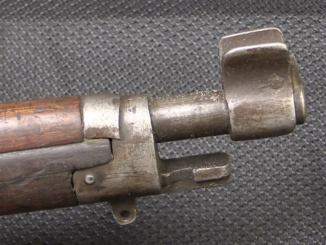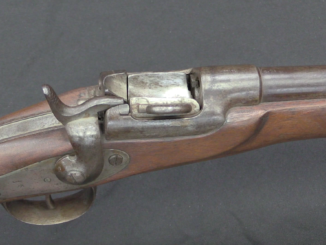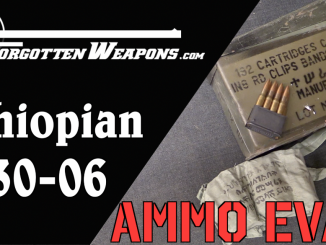The Austro-Hungarian Empire went into World War One with the Steyr M95 straight-pull rifle as its standard infantry arm. Heavy losses in just the first few months of the war made it clear that the existing stockpiles of those M95 rifles would not suffice, however. Older guns were pulled out of inventory, including Werndl and early straight pull rifles of the M88 and M88/90 patterns. These rifles had been designed around a black powder 8mm cartridge, and by 1915 many had heavily corroded bores. Some of these were rebarreled for active service using new rear sights of the M95 type – and thus we get the M88/95 pattern (this is a collector designation, not an official Austro-Hungarian one).
In addition to the rear sight and new barrel, it appears that these rifles were also fitted with upper handguards held in place by spring clips. Those hand guards are often missing, including on this example and every other one I saw that was imported from Ethiopia.
Thanks to InterOrdnance and Royal Tiger Imports for providing this rifle for filming!




I have two M1895 Carbines (with bayonet lugs). Both 8x56R, one is Hungarian
(Budapest) the other Austrian(Steyer 1903)both in tremendously good condition,
bright, sharp bores, etc. and bayonets/ scabbards. These were imported 15 to
20 years ago. Bores are .329″. Lee makes dies and a bullet mold of the correct
diameter and weight. Sporting ammo was available from Graffs and Hornady at one
time. Cases can be made from 7.62x54R Russian. I have boxed FMJ rounds marked
1939 with the Nazi Waffenamp on them. Mannlicher clips were also available. They shoot very well with my loads. These carbines were well cleaned and stored correctly after both World Wars. They were only about $80 each when I bought them.
Too bad these rifles were not as well preserved as my Carbines. Awfully expensive too.
PPU (as of its 2019 US catalog) still make the 8×56 cartridge with two .330 diameter bullet types (soft point and FMJ with boattail).
British Patent 13,787 dated 17th July 1894 was granted to AJ Boult, who appears to have been an agent for P Brun-Latrige. The illustration shows the ring trigger version without the cocking indicator on the striker. The magazine spring is not in the usual position under the follower. The follower has an extension working through a slot onto a coil spring in a parallel vertical hole in the backstrap.
P Brun-Latrige had several other British patents granted between 1888 to 1894, mainly to do with break or sliding action shotguns.
Looks like everyone was ill-prepared for wars of attrition. Good thing America didn’t get invaded either, or the same problem would show up on the western side of the Atlantic. There weren’t enough M1903 rifles to go equip the entire US Army, and many reserve soldiers were still using trapdoor-action rifles (if not the Krag-Jorgensen rifles)! I could be wrong.
Soldiers sent to Vladivostok and Murmansk were equipped with Mosin Nagants.
Yep: “U.S. magazine rifle, caliber 7.62mm Model of 1916.” National Guard and drill use stateside too! New England Westinghouse and Remington contracts cancelled, both factories bailed out by Uncle Sam to defray the losses, and in the end, the vast majority of doughboys in the AEF used the British-designed “Pattern 14” as the U.S. rifle, Model of 1917 or “American Enfield” with its excellent aperture sights… But not windage adjustable, so back to the 1903 Roosevelt Mauser after the war. We have John Taliaferro Thompson of Thompson SMG fame to thank for the use of Winchester, Remington, Eddystone excess factory capacity for that.
The U.S.rifle, Model of 1917 was indeed an excellent combat weapon. Very
few military rifles of that era had shooter adjustable sights. Reason?
Durability. The “Buffington” rear sight on the 1884 trap door, Krag and 1903 (yes, a Mauser patented) Springfield were excellent target sights but in combat they were easily damaged. Every try and use a peep sight
that far from your eye to find your target in a combat situation?
The receiver located rear sight on the U.S. 1917 Enfield was much easier
to use. Just like the rear sight on the 03-A3 spring field, M1 Garand,
M1 carbine, M14, etc. Yes these were all (except the early M1 carbine)
adjustable for elevation AND windage. Our military did learn, finally.
Granted the M1917 cocked on closing and required a different bayonet
and was not as smooth and hansom as the M1903. But it was a very rugged
and highly serviceable combat rifle.
Cherndog, I wish I could remember where I read it, but I remember State Guard troops raised after their National Guard was mobilized as being armed with old M1873 rifles and carbines and a variety of commercially available civilian arms, some of which the states had purchased to arm their pre-National Guard militias.
Italy was the only major Entente power left after the Bolshevik revolution in Russia, which was directly involved in combat against “Austro-Hungaria” (sorry, couldn’t resist). Consequenctly they received a lion’s share of Austro-Hungarian weapons as war reparations, anything from rifles to huge Skoda 420mm siege guns. Italy had more former Austro-Hungarian superheavy artillery pieces than any other country at the start of WW2 (including Austria and Hungary combined). The Germans had to loot a military museum in Vienna to get just a single additional Skoda 305mm siege mortar, but at the same time Italians had a bunch of them just sitting around. Since they were not well suited for the mobile combat in Africa, they were never used during WW2.
I know many of those Austrian captures/reparation guns were used in Africa, particularity by askari troops (due to non-standard calibers). Italy didn’t have an adequate supply of modern sidearms, so I imagine a number of Austrian Steyr-Hahns and Roth-Krnkas may have been issued as second-line/private purchase guns, not to mention heavier stuff like light or heavy machine guns (again, probably second-line).
Ironically, Italy sold a number of guns to Ethiopia before the second invasion in 1935 (I know stuff like Beretta M1918s and OVPs were sold as surplus), which may have included ex-Austrian gear, which Ethiopia did field. Probably mostly bought as surplus from the Austrians themselves, but it’s not unlikely Italy would have wanted to clean out any non-standard guns they had extra of.
One of my grandfathers, who served in the 8th Ohio Volunteer Infantry (OVI)in
the Spanish-American war in Cuba (joined the OVI in 1894)and then in the Ohio
National Guard, resigned his commission in 1912 (he was an officer). He tried to enter the Army for WWI but was not allowed to; he had six daughters. So he
entered the Ohio Home Guard (Militia) and guarded Lake Rockwell (Akron, Ohio’s
water supply) but had to furnish his own rifle. Most of our WWI troops used the
U.S. M1917 Enfield (.30-06). My other grandfather served in the Army from 1894
until 1946 (yes, 52 years…) and he died on active duty in 1946; I still have President Truman’s “letter”. Most of the trapdoors were gone by WWI but Krags
were indeed brought out of storage for U.S. basic training and guard duty by the regular military here in the states. For what its worth, Krag, ’03 Springfield and M1 Garand bayonets will interchange.
It’s interesting that the US Army considered bayonet interchangeability an important feature. Some other armies had different and noninterchangeable models of bayonets even for different versions of the same basic rifle design. I don’t know if the US Army ever had any shortages of bayonets, but both the Austo-Hungarians and Germans famously did and were forced to manufacture lower quality ‘Ersatz’ bayonets during WW1.
Very interesting! Certainly the felt-helmet-wearing “Keystone cops” lookalike Seattle PD in 1915-1916 had a rack of ex-Indian Wars surplus trapdoor Springfields if they ever thought they needed rifles.
The used of surplus military “long guns” was pretty common in law enforcement. In the mid 1950’s our local police had U.S Military Surplus Winchester M97 “trench guns” and M1 carbines. Some police departments still had M1 carbines into the 1980’s. Local police were offered M1 Garand rifles from the federal government for almost the cost of shipping. A few of my friends fathers who were police officers at the time bought one. And they still existamong family members.
The M1905 and M1 bayonets for the M1903 and M1 rifle are interchangeable but the M1892 Krag bayonet is not compatible with the later 2 rifles. It’s real close if you eyeball it but no cigar when you try to mount it.
I just mounted my Krag bayonet on my Krag, my ’03 Springfield (1918 mfg.), it is a MK1
with the Pederson ejection port in the reciever, and my M1 and it fits/ locks, unlocks
just fine. I did try my 03-A3 but they should be the same. The WEST POINT cadets used
Krag bayonets on their ,03 Springfields and ’03 springfield bayonets on their M1 rifles.
I know this is a 100% real U.S. Krag bayonet and scabard. Has the correct markings, etc.,and my 1894/ 1946 service record Grandfather walked off with it and an ’03 bayonet also which is still in my collection.
In addition to the fact that the Krag bayonet will indeed fit a ’03 and ’03A3 as well
as an M1 rifle, the West Point Cadets used the Krag bayonet on the M1 also until the
M14 replaced it.
The Polish Legion, at its inception (and they went into action on the very 6th August 1914), was partly equiped with these rifles, along with a comparable number of Werdnls. The ‘Leguny’ did not like them; they complained particularly against the lack of the wooden handgurds and on first occasion – per fas et nefas – were ‘exchanging’ their weapons for the newest Mannlicher model.